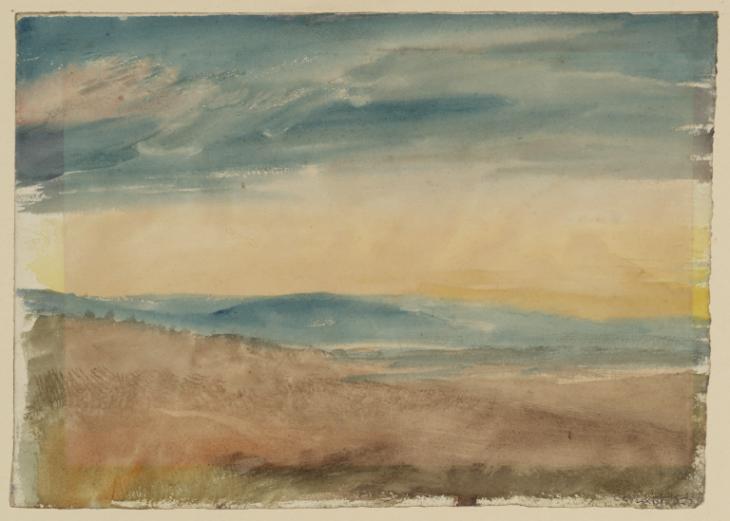Joseph Mallord William Turner ?Dartmoor c.1814-16
Joseph Mallord William Turner,
?Dartmoor
c.1814-16
Joseph Mallord William Turner 1775–1851
?Dartmoor c.1814–16
D25450
Turner Bequest CCLXIII 327
Turner Bequest CCLXIII 327
Watercolour on white wove paper, 170 x 240 mm
Blind-stamped with Turner Bequest monogram towards bottom right
Stamped in black ‘CCLXIII – 327’ bottom right
Blind-stamped with Turner Bequest monogram towards bottom right
Stamped in black ‘CCLXIII – 327’ bottom right
Accepted by the nation as part of the Turner Bequest 1856
Exhibition history
1869
Second Loan Collection selected from the Turner Bequest, various venues and dates 1869–before 1909 (no catalogue but numbered 29, as ‘Sunset (Colour)’).
References
1820
A.J. Finberg, A Complete Inventory of the Drawings of the Turner Bequest, London 1909, vol.II, p.839, CCLXIII 327, as ‘Sunset’, c.1820–30.
1975
Gerald Wilkinson, Turner’s Colour Sketches 1820–34, London 1975, p.152, as ‘Sunset or sunrise in hilly country’, reproduced in colour.
1991
Ian Warrell, ‘R.N. Wornum and the First Three Loan Collections: A History of the Early Display of the Turner Bequest outside London’, Turner Studies, vol.11, no.1, Summer 1991, p.43 no.29, as ‘Sunset (Colour)’.
1997
Eric Shanes, Turner’s Watercolour Explorations 1810–1842, exhibition catalogue, Tate Gallery, London 1997, pp.30, 58 under no.38, 94 Appendix I ‘Devonshire’, 103 Appendix I ‘Yorkshire’.
This atmospheric but relatively featureless twilight study resists precise connection to a particular site; nevertheless, Gerald Wilkinson declared that despite ‘the rather dreary foreground, the picture stands as a fine and complete statement’.1 There is some delicate hatching suggesting heathland vegetation. Eric Shanes has noted its similarity in terms of style,2 similar subject,3 and paper4 to a view he identified of Brent Tor and the Lydford Valley in Devon (Tate D25436; Turner Bequest CCLXIII 313), although he has also suggested views across Wharfedale near his patron Walter Fawkes’s Yorkshire home as potentially linked5 (see the ‘Farnley Hall and Yorkshire c.1808–24’ section of the present catalogue).
D25436 is based on a faint line drawing in the Devon Rivers, No.1 sketchbook (Tate D09506; Turner Bequest CXXXII 24), now dated to 1814. It is possible that the present work was developed from one of the slight views of successive hills and valleys on or around Dartmoor on adjacent pages, such as Tate D09491, D09497, D09503, D09505 or D09507 (Turner Bequest CXXXII 10, 15, 21, 23, 25). The last of these is a variant prospect of Brent Tor, while D09505 is identified by Turner’s inscription as showing the remote Cranmere Pool, at the head of the West Okement River in the middle of the northern half of the moor; the sources of the Taw, Tavy and East Dart rivers are nearby. As it seems reasonable to relate them, Shanes’s ‘?1813–16’ for the Brent Tor watercolour, revised to c.1814–16 in the present catalogue owing to the redating of its source drawing, has also used for the present work.
Although Shanes does not link the two sheets to any particular project,6 there could be a connection with the Rivers of Devon scheme of that period, as discussed in the Introduction to this section. Compare the bleak setting of the watercolour of a north-west Devon moorland scene (Yale Center for British Art, New Haven),7 engraved at about that time but not published until 1850 as Source of the Tamer [sic] & Torridge (Tate impression: T07093).
Technical notes:
In 1909 Finberg laconically noted: ‘Yellow faded’.1 This followed prolonged exposure in one of the touring Loan Collections.2 Gerald Wilkinson has observed that the ‘true brilliance of the colours can be seen at the unfaded edges – including a surprising green’3 where the blue horizon merges with the yellow sky. The centre is muted, with a rather bleary appearance where the tones of the faded colours and yellowed paper have converged.
Verso:
Blank; laid down.
Matthew Imms
July 2016
How to cite
Matthew Imms, ‘?Dartmoor c.1814–16 by Joseph Mallord William Turner’, catalogue entry, July 2016, in David Blayney Brown (ed.), J.M.W. Turner: Sketchbooks, Drawings and Watercolours, Tate Research Publication, February 2017, https://www

